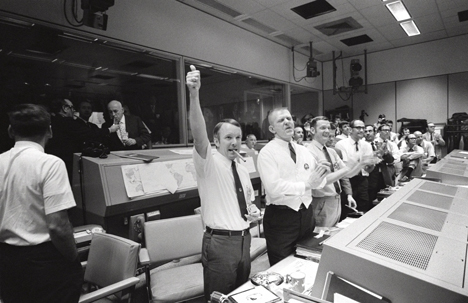
"The control room is a highly charged mythic space"
Opinion: when the team behind the Rosetta space mission landed Philae on a moving comet last week, they celebrated in a grey control room – the kind of uniquely bland space that has been the backdrop to some of the 21st century's most iconic moments, says Will Wiles.
The European Space Operations Centre control room at Darmstadt in Germany is a fairly sober space. It has grey walls, curved banks of desks and high-backed office chairs; the main visual interest comes from what those desks face, a wall thick with giant screens, relaying images and information from missions undertaken by the European Space Agency.
Last Wednesday those screens showed an astonishing triumph of technical skill and international cooperation: the Philae lander touching down, with a bit of a bounce, on the comet 67p/Churyumov-Gerasimenko, the climax of the Rosetta spacecraft's decade-long journey towards this hurtling snowball.
Confirmation that Philae had landed sparked celebrations in the control room – cheers, whoops, fist-pumps, hugs, handshakes, backslapping. These are familiar scenes. When a space mission pays off, this is the four-second clip that gets played on the evening news. And we've been treated to a few of these happy images lately.
In September the Indian Space Research Organisation's Mangalyaan mission went into orbit around Mars; the pictures from the ISRO control room in Bangalore were a delight, especially as the high number of female scientists present offered a welcome contrast with the often very male and pale impression we get of European and American missions. (China appears to be cagey about footage of its technicians celebrating.) The backdrop was the same: screens, grey walls, office chairs, suspended ceiling tiles.

These are the images of control room triumph – there are another two types of images that come out of this environment. The first is the "Before" shot: shirtsleeves rolled up, tense and focused, all eyes in a single direction, deep seriousness etched on every face, ostensibly unemotional but crackling with suppressed feeling and anxiety. And the flipside of the high-fives and mega-grins of success is the equally familiar "Failure" tableau: thousand-yard stares, heads in hands, tears, consoling arms around shoulders, the other kind of hugs. It's not just space missions that generate these images. One of the most memorable news photographs of recent years was President Obama in the White House situation room, waiting for news of the mission to kill Osama Bin Laden.
It's easy to see why these images are favoured by the evening news. An eruption of human joy, it's immediately legible, as opposed to a torrent of data or a wavering signal or a high-contrast black-and-white photograph or a jerky snatch of video, which might need interpretation or take a little more effort to understand. The story – which may be hideously complex – is immediately put in simple human terms. And Hollywood loves a good control room celebration; at times you sense the filmmakers really want to have balloons and confetti fall from the ceiling, but dull old Verity restrains them.
This makes the control room an interesting space – partly because it's such an uninteresting space. They may sometimes give a faint echo of Ken Adam's War Room set for Stanley Kubrick's Dr. Strangelove, but mostly the aesthetic is out-of-town office park with just a dash of private screening cinema. Technical mastery plants its feet on fawn carpet tiles. They must of course prioritise function, and public money is at stake. But they are also venues for high emotion, and semi-public spaces, on view to the waiting, taxpaying world. Their design matters.
It matters because the control room is a highly charged mythic space – even when the public is not allowed to gawp inside, perhaps even more so. Feel the emotional crackle in the journalistic metaphor of the "nerve centre". We are embedded in a technological civilisation and our survival depends on a number of hugely complicated infrastructural systems: power, water, gas, transport, food logistics, information networks. The failure of any one of these systems, even briefly, could mean chaos and cost lives. To rest easy we need to believe that somewhere in the system there is a room full of people who know what they're doing. Call it the myth of competence – a fundamental, but not often remarked, part of the psychology of the modern age. Somewhere there is a control room, an advanced society's equivalent of the throne room, with anonymous, highly trained professionals in the role of wise monarch.
A few months ago, reviewing Command and Control by Eric Schlosser – a fascinating history of the United States' nuclear arsenal – I argued that the post-Second World War era had given rise to a new kind of drama, the Breakdown Tragedy, in which the ultra-capable technical personnel we completely depend upon find themselves overwhelmed by disaster. The heart of Schlosser's book, dealing with the near-catastrophic "Damascus Incident" of 1980, is one of these stories; Ron Howard's film Apollo 13 is the most obvious example in art.
The control room is the stage set of these dramas, and technological triumphs like the one we saw last week, and the more prosaic everyday story of keeping this whole show on the road. Apollo 13 is, at least, fairly documentary; control-room sets are sometimes risibly flashy and high-tech. It is a theatre of the 21st-century subconscious, part of the dreamworld of modernism. Perhaps that is why the decor is kept so muted: to stress that everything is normal here, everything is as planned and unexceptional, and we can safely look away.
This is similar to the stifling propriety of the Victorian drawing room, and one is left wondering what repressed passions and terrors are kept at bay behind all those neutral acoustic panels. Perhaps the underlying horror of it all is that there is nothing in the room to be controlled, it is all elsewhere. All the action takes place on screens, which is to say it isn't really action at all.
If the reassuring dream of the 21st century is that somewhere a talented and alert man or woman is sitting at a fibre-optic hub, making adjustments as required, poised to respond in an emergency, then the corresponding nightmare is that they, like us, are just powerlessly watching events unfold on TV. It takes light 28 minutes to reach the comet 67p – far too great a lag to steer a landing directly. The unbelievable fact about Philae's landing is that it was programmed in advance.
Will Wiles is the author of two novels with architectural themes: Care of Wooden Floors, in which a man is driven mad by a minimalist apartment, and The Way Inn, a horror story set in an anonymous chain hotel. He is contributing editor at Icon magazine and a freelance design journalist.